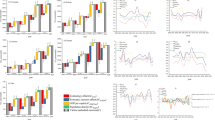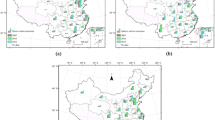Abstract
Rapid and large scale construction activities consume significant resources and make impacts on the environment. To support policy for emission reduction and route of low-carbon society development, this paper estimated building stocks and building embodied carbon emissions (BECEs) in China’s 31 provinces from 1997 to 2016 by material flow analysis (MFA). Furthermore, global and local Moran’s indices were employed to investigate the geographical clustering patterns, and temporal and spatial decomposition models were proposed to identify the driving forces. The results reveal the total BECEs has boomed from 9.67 billion tons in 1997 to 28.99 billion tons in 2016. BECEs in 31 provinces have experienced consistent increase but obvious differences in growth rate, and are spatially inclined to decrease from eastern coastal regions to western inland regions. The change of spatial agglomeration pattern is complex and variable. It presents that a long and narrow “H-L agglomeration” is located in the two northernmost provinces and the other 29 provinces enforce a sequence arrangement with an order of “H–H”, “L–H”, “H–L”, and “L–L” from east to west. Temporal decomposition results show that investment scale, economic level, and population density are the main driving forces for the increase of BECEs from both national and provincial levels, while the main reasons for the decrease are technical level and return on investment. Spatial decomposition results demonstrate that population density and provincial area are the main driving forces for the difference between provincial and national average, and others cause the difference among provinces.








Similar content being viewed by others
Data availability
The datasets used or analyzed during the current study are available from the corresponding author on reasonable request.
References
Ang BW (2005) The LMDI approach to decomposition analysis: a practical guide. Energy Policy 33(7):867–881. https://doi.org/10.1016/j.enpol.2003.10.010
Ang BW, Xu XY, Su B (2015) Multi-country comparisons of energy performance: the index decomposition analysis approach. Energy Econ 47:68–76. https://doi.org/10.1016/j.eneco.2014.10.011
Ang BW, Su B, Wang H (2016) A spatial–temporal decomposition approach to performance assessment in energy and emissions. Energy Econ 60:112–121. https://doi.org/10.1016/j.eneco.2016.08.024
Anselin L (1995) Local indicators of spatial association-LISA. Geogr Anal 27(2):93–115. https://doi.org/10.1111/j.1538-4632.1995.tb00338.x
Asif M, Muneer T, Kelley R (2007) Life cycle assessment: a case study of a dwelling home in Scotland. Build Environ 42(3):1391–1394. https://doi.org/10.1016/j.buildenv.2005.11.023
Bai J, Qu JS, Maraseni TN, Wu J, Xu L, Fan Y (2019) Spatial and temporal variations of embodied carbon emissions in China’s infrastructure. Sustainability 11(3):749. https://doi.org/10.3390/su11030749
Brattebø H, Bergsdal H, Sandberg NH, Hammervold J, Müller DB (2009) Exploring built environment stock metabolism and sustainability by systems analysis approaches. Build Res Inf 37(5–6):569–582. https://doi.org/10.1080/09613210903186901
Cai Z, Shen L, Liu LT (2017) Estimating the in-use cement stock in China: 1920-2013. Resour Conserv Recycl 122:21–31. https://doi.org/10.1016/j.resconrec.2017.01.021
Cao WX (2015) Research on temporal and spatial variations of material metabolism and its environmental effects of Shanghai's urban infrastructure for recent 30 years. Dissertation, East China Normal University
Chau CK, Hui WK, Ng WY, Powell G (2012) Assessment of CO2 emissions reduction in high-rise concrete office buildings using different material use options. Resour Conserv Recycl 61:22–34. https://doi.org/10.1016/j.resconrec.2012.01.001
Feng B (2015) Reaserch on the calculation and analysis of CO2 emission and energy environmental efficiency of construction industry. Dissertation, Tianjin University
Feng B, Wang XQ (2015) Research on carbon decoupling effect and influence factors of provincial construction industry in China. China Popul Resour Environ 04:28–34 (in Chinese)
Gan Vincent JL, Cheng Jack CP, Lo Irene MC et al (2016) Developing a CO2-e accounting method for quantification and analysis of embodied carbon in high-rise buildings. J Clean Prod 141:825–836. https://doi.org/10.1016/j.jclepro.2016.09.126
Global Carbon Project (GCP) (2018) The global carbon project open data of CO2 emissions. Available online: http://www.globalcarbonatlas.org/en/content/welcome-carbon-atlas (accessed on 13 Jan 2019)
Grimm NB, Faeth SH, Golubiewski NE, Redman CL, Wu J, Bai X, Briggs JM (2008) Global change and the ecology of cities. Science 319(5864):756–760 www.sciencemag.org/cgi/content/full/319/5864/756/DC1
Han J, Xiang WN (2013) Analysis of material stock accumulation in China’s infrastructure and its regional disparity. Sustain Sci 8:53–564. https://doi.org/10.1007/s11625-012-0196-y
Hong LX, Zhou N, Feng W, Khanna N, Fridley D, Zhao Y, Sandholt K (2016) Building stock dynamics and its impacts on materials and energy demand in China. Energy Policy 94:47–55. https://doi.org/10.1016/j.enpol.2016.03.024
Hu MM, Pauliuk S, Wang T, Huppes G, van der Voet E, Müller DB (2010) Iron and steel in Chinese residential buildings: a dynamic analysis. Resour Conserv Recycl 54(9):591–607. https://doi.org/10.1016/j.resconrec.2009.10.016
Huang SL, Hsu WL (2003) Materials flow analysis and energy evaluation of Taipei’s urban construction. Landsc Urban Plan 63(2):61–74. https://doi.org/10.1016/S0169-2046(02)00152-4
Huang T, Shi F, Fei JL, Tanikawa H, Imura H (2010) Study on the material stock of transportation construction associated with the development of infrastructure in China. Environ. Inf Sci 24:149–154
Huang T, Shi F, Tanikawa H, Fei J, Han J (2013) Materials demand and environmental impact of buildings construction and demolition in China based on dynamic material flow analysis. Resour Conserv Recycl 72:91–101. https://doi.org/10.1016/j.resconrec.2012.12.013
Li H, Zhao YH, Qiao XY (2017) Identifying the driving forces of national and regional CO2 emissions in China: based on temporal and spatial decomposition analysis models. Energy Econ 68:522–538. https://doi.org/10.1016/j.eneco.2017.10.024
Liu JB (2019) Study on the spatiotemporal pattern of life cycle CO2 emissions of Shanghai’s infrastructure on fine spatial scale. Dissertation, East China Normal University
Liu TX, Hu D (2006) Environmental impact of residential building construction in Beijing: 1949~2003—Assessing the construction materials' environmental impact by LCA. J Grad Sch Chin Acad Sci 23:231–241
Lu H, Shi JC (2012) Reconstruction and analysis of temporal and spatial variations in surface soil moisture in China using remote sensing. Chin Sci Bull 57(16):1412–1422 (in Chinese)
Lv WQ (2015) The research of metabolism of urban residential buildings- the case of Beijing city. Dissertation, Nanjing Agriculture University
Ma MD, Cai W, Cai WG (2018) Carbon abatement in China’s commercial building sector: a bottom-up measurement model based on Kaya-LMDI methods. Energy 165:350–368. https://doi.org/10.1016/j.energy.2018.09.070
MCC (Ministry of Construction P. R. China) (2001) Unified standard for reliability design of building structures GB 50068-2001. ChinaArchitecture & Building Press, Beijing
Michieka NM, Fletcher J, Burnett W (2013) An empirical analysis of the role of China’s exports on CO2 emissions. Appl Energy 104:258–267. https://doi.org/10.1016/j.apenergy.2012.10.044
Müller DB (2006) Stock dynamics for forecasting material flows— case study for housing in the Netherlands. Ecol Econ 59(1):142–156. https://doi.org/10.1016/j.ecolecon.2005.09.025
National Bureau of Statistics of China (NBSC) (2014) New China in 65 years. China Statistics Press, Beijing
NBSC (National Bureau of Statistics of China) (1998-2017) China statistical yearbook. China Statistics Press, Beijing
OECD (Organization for Economic Co-operation and Development) (2010) Measuring capital OECD manual. Measurement of capital stocks, consumption of fixed capital and capital services. http://www.oecd.org
Sandberg NH, Sartori I, Heidrich O, Dawson R, Dascalaki E, Dimitriou S, Vimm-r T, Filippidou F, Stegnar G, Šijanec Zavrl M, Brattebø H (2016) Dynamic building stock modelling: application to 11 European countries to support the energy efficiency and retrofit ambitions of the EU. Energy Build 132:26–38. https://doi.org/10.1016/j.enbuild.2016.05.100
Sandberg NH, Sartori I, Vestrum MI, Brattebø H (2017) Using a segmented dynamic dwelling stock model for scenario analysis of future energy demand: the dwelling stock of Norway 2016-2050. Energy Build 146:220–232. https://doi.org/10.1016/j.enbuild.2017.04.016
Shang CJ, Chu CL, Zhang ZH (2011) Quantitative assessment on carbon emission of different structures in building life cycle. Build Sci 27(12):66–70 (in Chinese)
Shen LN (2013) Study on construction of ecological city based on materal-energy metabolism-take the global city of Xi’ an as example. Dissertation, Northwest University
Shi F, Huang T, Tanikawa H, Han J, Hashimoto S, Moriguchi Y (2012) Toward a low carbon—dematerialization society. J Ind Ecol 16(4):493–505. https://doi.org/10.1111/j.1530-9290.2012.00523.x
Su YX (2015) Study on the carbon emissions from energy consumption in China using DMSP/OLS night light imageries. Dissertation, University of Chinese Academy of sciences
The World Bank (WB) (2018) The World Bank Open Data of Carbon Emissions. Available online: https://data.worldbank.org.cn/ (accessed on 13 Jan 2019)
You F, Hu D, Zhang HT, Guo Z, Zhao Y, Wang B, Yuan Y (2011) Carbon emissions in the life cycle of urban building system in China—a case study of residential buildings. Ecol Complex 8:201–212. https://doi.org/10.1016/j.ecocom.2011.02.003
Zhang T, Jiang YH, Huang YL, Zhang CX, Wu JJ (2010) Carbon emission factors of energy and materials commonly used in buildings. Inf China Constr 23:58–59
Acknowledgments
We are very grateful to the editor and reviewers for their constructive comments and suggestions on the manuscript.
Funding
This work is funded by the National Key Research and Development Program of China (No. 2016YFA0602803).
Author information
Authors and Affiliations
Contributions
All authors contributed to the study conception and design. Jing Bai carried out the literature search, data collection, statistical analysis, and first draft of the manuscript editing. Jiansheng Qu performed the manuscript review and provided funding acquisition. All authors have read and approved the content of the manuscript.
Corresponding author
Ethics declarations
Ethical approval
All authors listed have approved the manuscript that is enclosed.
Competing interests
The authors declare that they have no conflict of interest.
Additional information
Responsible editor: Marcus Schulz
Publisher’s note
Springer Nature remains neutral with regard to jurisdictional claims in published maps and institutional affiliations.
We would like to declare that the work described was original research that has not been published previously, and not under consideration for publication elsewhere, in whole or in part.
Rights and permissions
About this article
Cite this article
Bai, J., Qu, J. Investigating the spatiotemporal variability and driving factors of China’s building embodied carbon emissions. Environ Sci Pollut Res 28, 19186–19201 (2021). https://doi.org/10.1007/s11356-020-11971-x
Received:
Accepted:
Published:
Issue Date:
DOI: https://doi.org/10.1007/s11356-020-11971-x




